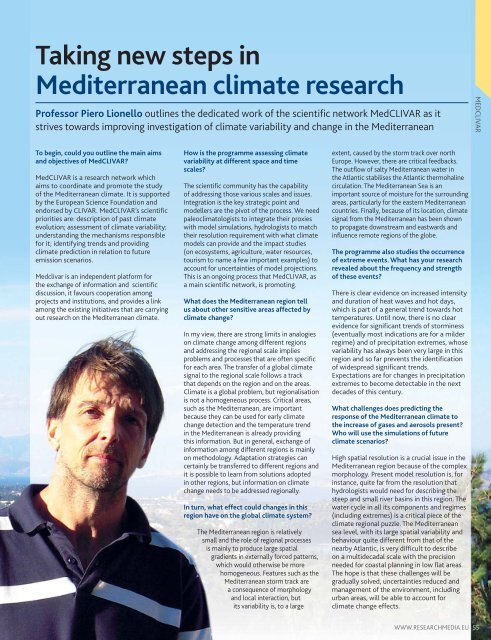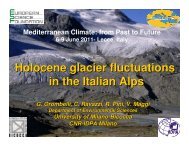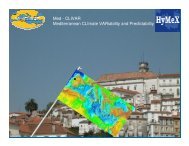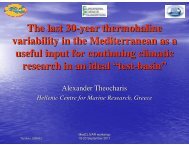Taking new steps in Mediterranean climate research - Medclivar
Taking new steps in Mediterranean climate research - Medclivar
Taking new steps in Mediterranean climate research - Medclivar
Create successful ePaper yourself
Turn your PDF publications into a flip-book with our unique Google optimized e-Paper software.
<strong>Tak<strong>in</strong>g</strong> <strong>new</strong> <strong>steps</strong> <strong>in</strong><strong>Mediterranean</strong> <strong>climate</strong> <strong>research</strong>Professor Piero Lionello outl<strong>in</strong>es the dedicated work of the scientific network MedCLIVAR as itstrives towards improv<strong>in</strong>g <strong>in</strong>vestigation of <strong>climate</strong> variability and change <strong>in</strong> the <strong>Mediterranean</strong>MEDCLIVARTo beg<strong>in</strong>, could you outl<strong>in</strong>e the ma<strong>in</strong> aimsand objectives of MedCLIVAR?MedCLIVAR is a <strong>research</strong> network whichaims to coord<strong>in</strong>ate and promote the studyof the <strong>Mediterranean</strong> <strong>climate</strong>. It is supportedby the European Science Foundation andendorsed by CLIVAR. MedCLIVAR’s scientificpriorities are: description of past <strong>climate</strong>evolution; assessment of <strong>climate</strong> variability;understand<strong>in</strong>g the mechanisms responsiblefor it; identify<strong>in</strong>g trends and provid<strong>in</strong>g<strong>climate</strong> prediction <strong>in</strong> relation to futureemission scenarios.<strong>Medclivar</strong> is an <strong>in</strong>dependent platform forthe exchange of <strong>in</strong>formation and scientificdiscussion, it favours cooperation amongprojects and <strong>in</strong>stitutions, and provides a l<strong>in</strong>kamong the exist<strong>in</strong>g <strong>in</strong>itiatives that are carry<strong>in</strong>gout <strong>research</strong> on the <strong>Mediterranean</strong> <strong>climate</strong>.How is the programme assess<strong>in</strong>g <strong>climate</strong>variability at different space and timescales?The scientific community has the capabilityof address<strong>in</strong>g those various scales and issues.Integration is the key strategic po<strong>in</strong>t andmodellers are the pivot of the process. We needpaleoclimatologists to <strong>in</strong>tegrate their proxieswith model simulations, hydrologists to matchtheir resolution requirement with what <strong>climate</strong>models can provide and the impact studies(on ecosystems, agriculture, water resources,tourism to name a few important examples) toaccount for uncerta<strong>in</strong>ties of model projections.This is an ongo<strong>in</strong>g process that MedCLIVAR, asa ma<strong>in</strong> scientific network, is promot<strong>in</strong>g.What does the <strong>Mediterranean</strong> region tellus about other sensitive areas affected by<strong>climate</strong> change?In my view, there are strong limits <strong>in</strong> analogieson <strong>climate</strong> change among different regionsand address<strong>in</strong>g the regional scale impliesproblems and processes that are often specificfor each area. The transfer of a global <strong>climate</strong>signal to the regional scale follows a trackthat depends on the region and on the areas.Climate is a global problem, but regionalisationis not a homogeneous process. Critical areas,such as the <strong>Mediterranean</strong>, are importantbecause they can be used for early <strong>climate</strong>change detection and the temperature trend<strong>in</strong> the <strong>Mediterranean</strong> is already provid<strong>in</strong>gthis <strong>in</strong>formation. But <strong>in</strong> general, exchange of<strong>in</strong>formation among different regions is ma<strong>in</strong>lyon methodology. Adaptation strategies cancerta<strong>in</strong>ly be transferred to different regions andit is possible to learn from solutions adopted<strong>in</strong> other regions, but <strong>in</strong>formation on <strong>climate</strong>change needs to be addressed regionally.In turn, what effect could changes <strong>in</strong> thisregion have on the global <strong>climate</strong> system?The <strong>Mediterranean</strong> region is relativelysmall and the role of regional processesis ma<strong>in</strong>ly to produce large spatialgradients <strong>in</strong> externally forced patterns,which would otherwise be morehomogeneous. Features such as the<strong>Mediterranean</strong> storm track area consequence of morphologyand local <strong>in</strong>teraction, butits variability is, to a largeextent, caused by the storm track over northEurope. However, there are critical feedbacks.The outflow of salty <strong>Mediterranean</strong> water <strong>in</strong>the Atlantic stabilises the Atlantic thermohal<strong>in</strong>ecirculation. The <strong>Mediterranean</strong> Sea is animportant source of moisture for the surround<strong>in</strong>gareas, particularly for the eastern <strong>Mediterranean</strong>countries. F<strong>in</strong>ally, because of its location, <strong>climate</strong>signal from the <strong>Mediterranean</strong> has been shownto propagate downstream and eastwards and<strong>in</strong>fluence remote regions of the globe.The programme also studies the occurrenceof extreme events. What has your <strong>research</strong>revealed about the frequency and strengthof these events?There is clear evidence on <strong>in</strong>creased <strong>in</strong>tensityand duration of heat waves and hot days,which is part of a general trend towards hottemperatures. Until now, there is no clearevidence for significant trends of storm<strong>in</strong>ess(eventually most <strong>in</strong>dications are for a milderregime) and of precipitation extremes, whosevariability has always been very large <strong>in</strong> thisregion and so far prevents the identificationof widespread significant trends.Expectations are for changes <strong>in</strong> precipitationextremes to become detectable <strong>in</strong> the nextdecades of this century.What challenges does predict<strong>in</strong>g theresponse of the <strong>Mediterranean</strong> <strong>climate</strong> tothe <strong>in</strong>crease of gases and aerosols present?Who will use the simulations of future<strong>climate</strong> scenarios?High spatial resolution is a crucial issue <strong>in</strong> the<strong>Mediterranean</strong> region because of the complexmorphology. Present model resolution is, for<strong>in</strong>stance, quite far from the resolution thathydrologists would need for describ<strong>in</strong>g thesteep and small river bas<strong>in</strong>s <strong>in</strong> this region. Thewater cycle <strong>in</strong> all its components and regimes(<strong>in</strong>clud<strong>in</strong>g extremes) is a critical piece of the<strong>climate</strong> regional puzzle. The <strong>Mediterranean</strong>sea level, with its large spatial variability andbehaviour quite different from that of thenearby Atlantic, is very difficult to describeon a multidecadal scale with the precisionneeded for coastal plann<strong>in</strong>g <strong>in</strong> low flat areas.The hope is that these challenges will begradually solved, uncerta<strong>in</strong>ties reduced andmanagement of the environment, <strong>in</strong>clud<strong>in</strong>gurban areas, will be able to account for<strong>climate</strong> change effects.WWW.RESEARCHMEDIA.EU 55
Each strategic workshop that MedCLIVARcoord<strong>in</strong>ates gathers around 50 participants– ma<strong>in</strong>ly from European countries – toconcentrate on a particular priority related tothe <strong>Mediterranean</strong> <strong>climate</strong>.The network organised two summer schoolsdur<strong>in</strong>g MedCLIVAR’s third and fifth years ofoperation. These schools tackled a range ofissues through means of keynote talks, tutorialsand <strong>in</strong>teractive sessions. The first of thesesummer schools, entitled ‘Climate variabilityover the <strong>Mediterranean</strong> area: Atmospheric andOceanic components’ was led by 16 tutors andattended by 54 PhD students from all overEurope and Morocco. The school’s presid<strong>in</strong>gtopics <strong>in</strong>cluded sea level and w<strong>in</strong>d changes;observed changes <strong>in</strong> both atmospheric andoceanic circulation; and the management of<strong>climate</strong> change policy.The second school has been called ‘The<strong>Mediterranean</strong> Climate System and RegionalClimate Change’, it has been held <strong>in</strong> 2010,Miramare, Trieste, Italy. This school has coveredtopics related to the observation, understand<strong>in</strong>gand modell<strong>in</strong>g of the <strong>Mediterranean</strong> <strong>climate</strong>system, its <strong>in</strong>teractions with Earth’s global<strong>climate</strong>, its natural variability and its responseto anthropogenic and natural forc<strong>in</strong>gs.MedCLIVAR’s exchange programme typicallylasted up to 18 weeks for students and 15days for senior <strong>research</strong>ers. The aim for eachprogramme was to exchange <strong>in</strong>formation,share data and exploit the expertise availablebetween members of the MedCLIVARnetwork. The exchange programme alsoallowed young students to ga<strong>in</strong> valuableexpertise <strong>in</strong> specific areas.MedCLIVAR co-sponsors scientific meet<strong>in</strong>gsand conferences, and these have led to a varietyof <strong>in</strong>stitutions and nations com<strong>in</strong>g together toreview <strong>climate</strong> extremes, <strong>climate</strong> evolution andother such important issues.RESEARCH FOR THE FUTUREMedCLIVAR has had a positive effect on thescientific community, lead<strong>in</strong>g to an <strong>in</strong>crease <strong>in</strong>the shar<strong>in</strong>g of <strong>in</strong>formation and vital educationprovided to young scientists. MedCLIVAR itselfhas even become part of that <strong>in</strong>formation.Every year, the network holds a session atthe European Geosciences Union (EGU)general assembly. Furthermore, severalroundtables were held to distribute <strong>new</strong>sabout MedCLIVAR activities and to advertise<strong>new</strong> projects and <strong>in</strong>itiatives. The events are cosponsoredby EGU.Although MedCLIVAR wishes to cont<strong>in</strong>ue itsactions with<strong>in</strong> the scientific community, 2011is its f<strong>in</strong>al year of fund<strong>in</strong>g from the ESF. Thenetwork plans for a f<strong>in</strong>al conference and a bookto be published, which will be distributed at theevent. Lionello recognises that, although the<strong>Mediterranean</strong> has been exhaustively explored<strong>in</strong> terms of <strong>climate</strong> change and MedCLIVAR hashelped significantly, there are still many aspectsof regional evolution that have not been explored.Successful networks like MedCLIVAR act as apositive example for similar and related projectsto receive grants <strong>in</strong> the future: “It is important tocont<strong>in</strong>ue hav<strong>in</strong>g streams of fund<strong>in</strong>g for bottomup<strong>in</strong>itiatives that do not respond to a thematiccall, but represent the free objectives of thescientific community. The success of MedCLIVARconfirms the importance of network<strong>in</strong>g as a ma<strong>in</strong>tool for the progress of science,”.FIGURE 2. Average change <strong>in</strong>surface air temperature at theend of the 21 st Century for thefour seasons based on a multiglobal model ensemble.F Giorgi and P Lionello, (2008),Climate Change Projectionsfor the <strong>Mediterranean</strong> Region,Global and Planetary Changevol 3, pp 90-104 doi:10.1016/jgloplacha 2007.09.00INTELLIGENCEMEDCLIVARMEDITERRANEAN CLIMATE VARIABILITYAND PREDICTABILITYOBJECTIVESTo coord<strong>in</strong>ate and promote <strong>research</strong> on the<strong>Mediterranean</strong> <strong>climate</strong> that <strong>in</strong>vestigates<strong>climate</strong> past evolution, <strong>climate</strong> variability,the mechanisms responsible for it, <strong>climate</strong>trends and provid<strong>in</strong>g <strong>climate</strong> prediction <strong>in</strong>relation to future emission scenarios.FUNDINGEndorsed by CLIVAR and funded by theEuropean Science Foundation (ESF) throughthe follow<strong>in</strong>g organisations:Fonds zur Förderung der WissenschaftlichenForschung, Austria • Research PromotionFoundation, Cyprus • Centre Nationalde la Recherche Scientifique/InstitutNational des Sciences de l’Univers, France• Deutsche Forschungsgeme<strong>in</strong>schaft,Germany • National Hellenic ResearchFoundation, Greece • Israel Academy ofSciences and Humanities, Israel • M<strong>in</strong>isterodell’Ambiente e della Tutela del Territorioe del Mare, Italy • Fundação para e Ciênciae a Tecnologia, Portugal • Consejo Superiorde Investigaciones Cientificas, M<strong>in</strong>isterio deEducacion y Ciencia, Spa<strong>in</strong> • SchweizerischerNationalfonds zur Förderung derwissenschaftlichen Forschung, Switzerland• Scientific and Technical Research Councilof Turkey, Turkey • Natural EnvironmentResearch Council, UKCONTACTProfessor Piero LionelloProject Coord<strong>in</strong>atorUniversity of SalentoDepartment of Material SciencesVia per Arnesano73100 Lecce, ItalyT +39 0832 297085F +39 0832 297100E piero.lionello@unisalento.itPIERO LIONELLO has worked <strong>in</strong>environmental <strong>research</strong> s<strong>in</strong>ce 1987.He is currently the coord<strong>in</strong>ator of theMedCLIVAR programme and has worked<strong>in</strong> his current position as Professor at theUniversity of Salento, Italy s<strong>in</strong>ce 1999.His present <strong>research</strong> <strong>in</strong>terests focus onthe <strong>Mediterranean</strong> <strong>climate</strong> and its futureevolution, with an emphasis on mar<strong>in</strong>estorm<strong>in</strong>ess and <strong>climate</strong> extremes.WWW.RESEARCHMEDIA.EU 57






